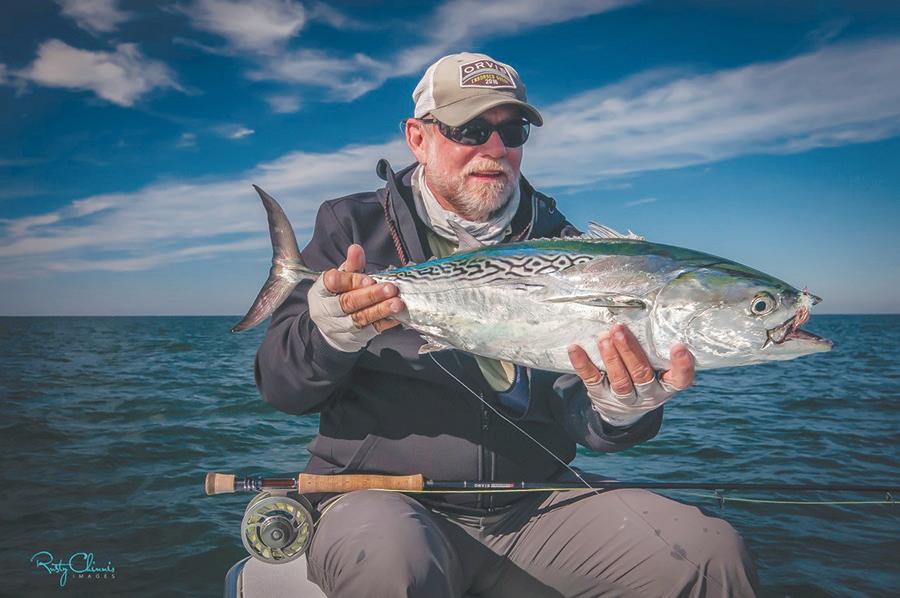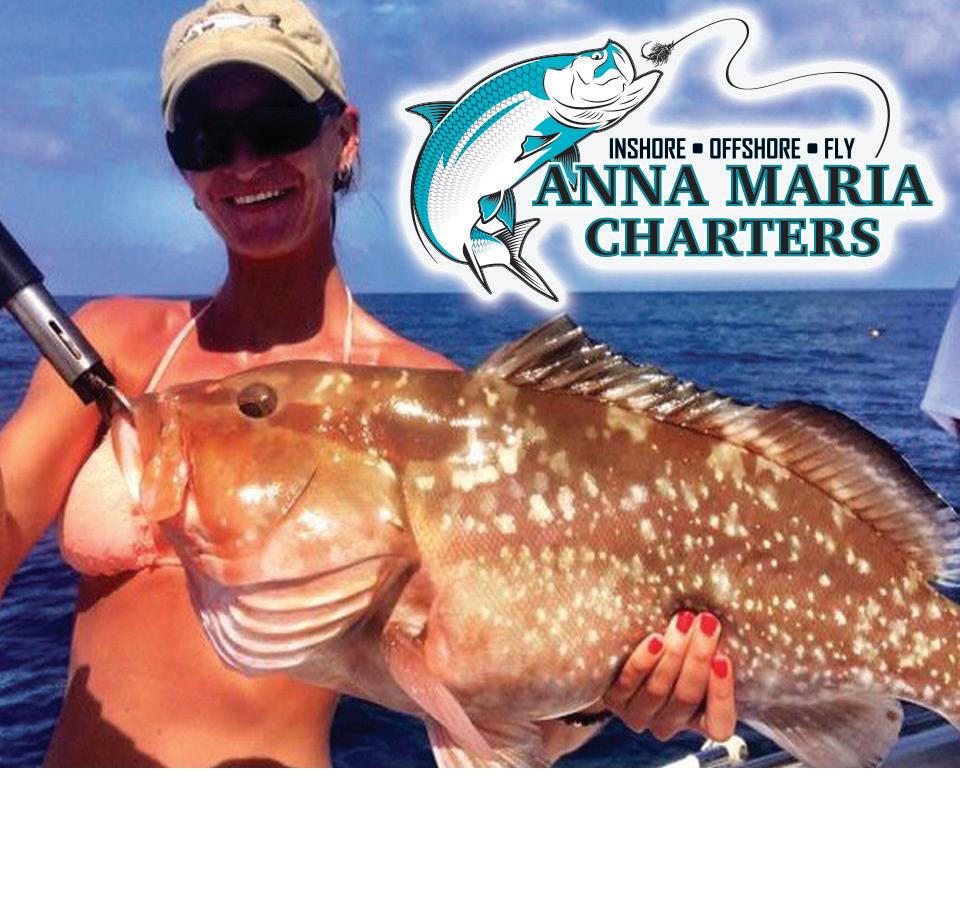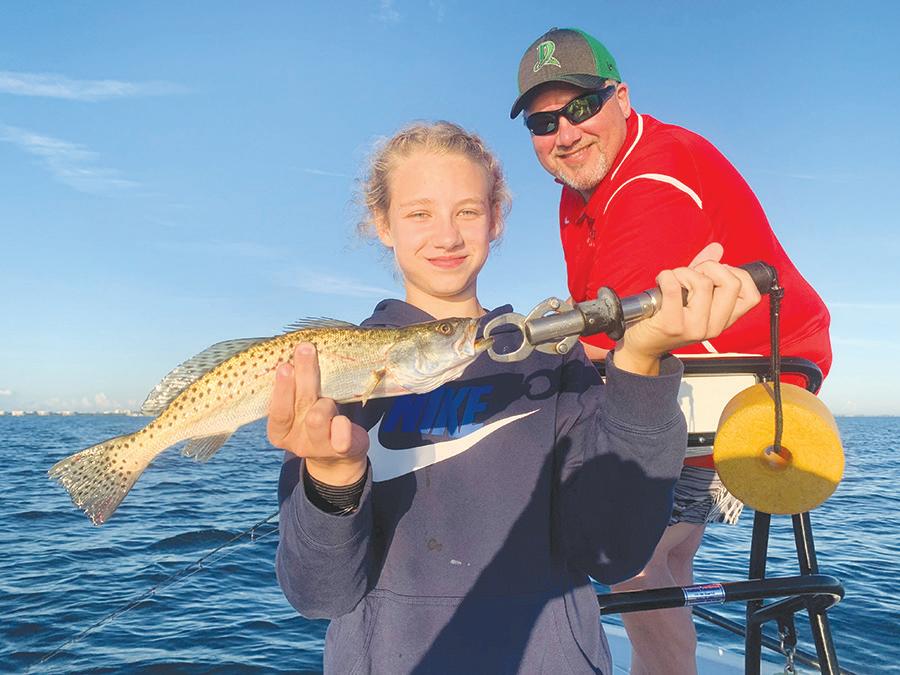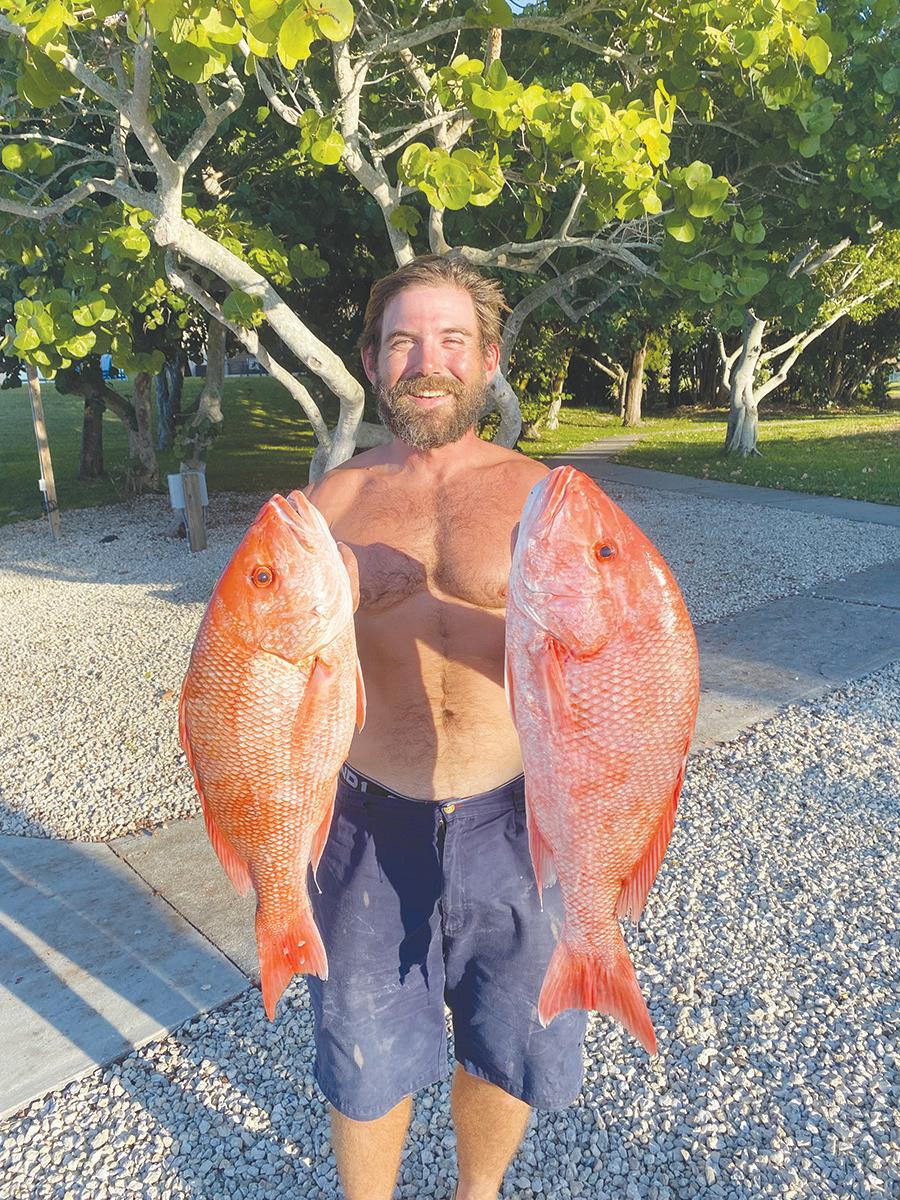
7 minute read
OUTDOORS
18 THE SUN OUTDOORS OCTOBER 27, 2021
Reel Time
RUSTY CHINNIS
Little tunny, one of my favorite species to catch on the fly, has essentially been missing for the last two years. Sure, anglers have encountered them during this time, but I haven’t found them to be a reliable target. Years ago, we would travel to Harker’s Island on North Carolina's Outer Banks for the fall blitz. Then over time, they became a reliable target off our beaches during the spring and fall. The only reason I can come up with for their absence is the persistent red tide that ruined the tarpon fishing during July and now threatens our fall run of Spanish mackerel, kingfish and little tunny. I’ve got my fingers crossed this season and keep thinking back to one of the last runs we had in the Tampa Bay area. This is how I described it.
The water was flat and there was no sign of life as we neared the Tampa Bay shipping channel. Word was out that little tunny and Spanish mackerel were attacking baitfish in and along the edges of the waterway, but as far as we could see, the water was flat and mirrorsmooth without a hint of action. After 10 minutes of surveying the waters in an easterly direction towards the Skyway Bridge, we were starting to wonder if the run from Longboat Key was a mistake. Then I remembered a day a few years back with Captain Rick Grassett, who was accompanying me, and I had a similar experience off Longboat Pass. Just as we were beginning to consider fishing in the bay instead of the Gulf, a striking fish exploded on the surface. After that, we were surrounded by action that lasted the whole morning.
No sooner had we uttered those words when baitfish started to show on the surface followed by diving birds and striking fish. Running to the nearest feeding frenzy, we cut the motor 20 yards away and launched small clousers into the melee. Almost immediately Grassett’s line came tight as a little tunny inhaled the fly. The fish bolted in a burst of speed that makes little tunny such a sought-after target. Grassett’s rod bent deeply as he applied pressure in an attempt to slow the fishes’ run as backing disappeared from his spool. The gamey fish would have nothing of it and ran another 20 yards of backing into the depths of the channel. After several more runs and a battle near the boat I was able to grab the little tunny’s tail and swing it into the boat for a quick picture. As quickly as we could, we launched the fast-swimming fish into the bay to give it a head start.
After the first fish, we found them challenging to intercept. Fish were exploding everywhere, but more often than not they would sound before we could get flies into the carnage. This is a common experience, but we knew to run up to a school as fast as possible and make casts before they sounded. Employing that technique, we were able to catch four little tunny each and several mackerel before we decided to try the beaches on our return south.
We didn’t find any action on the return to Longboat, but we had a great day of action and were content to enjoy a smooth ride home in the Gulf. Little tunny should be in local waters until cold spells send them south. That’s a lot of time to enjoy some spectacular action. If you go, look for birds and breaking fish along the Gulf coast. Small flies and spoons that mimic the baitfish work best. Now is the time to enjoy some of the hottest rodbending action of the year!
That was a memorable day and anglers should be on the lookout for action in the Gulf, especially after the first strong front sends water temperatures into the 70s. Little tunny will take any good baitfish pattern that matches the bait they’re after, but I love to watch them attack a top water fly. My favorite is a small Crease fly. Whatever fly you use, it’s important to hone your casting and be able to make the first cast count. More times than not, that will be your best and last opportunity!

Little tunny time?
Captain Rick Grassett landed this speedy little tunny on his "Night Snook Fly."
RUSTY CHINNIS | SUN















Redfish schooling inshore
CAPTAIN DAVE WHITE
This last week has really been stellar for fishing in our area. With fall creeping in a bit, fish feel the change coming. Although the full moon can have an adverse effect on offshore snapper, for the most part, things have been great.
Inshore, there are large redfish schools in quite a few places. If you’re lucky enough to get one to yourself, it can make for a great day. Also, mangrove snapper are feeding well in the bay and surrounding areas.
Offshore, American red snapper are still on our list. With a short extension on the season for charter boats, we’ve been taking advantage. The blackfin tuna have been making an appearance as well. Always a welcome addition to the fish box!
CAPTAIN RICK GRASSETT
Anglers fishing with me out of CB’s Saltwater Outfitters on Siesta Key had some action catching and releasing trout, blues, jacks and Spanish mackerel in Sarasota Bay and a bonus cobia in the Gulf on flies and DOA Lures on several trips recently.
Dan Patterson, from Siesta Key, fished with me and had some action catching and releasing several Spanish mackerel and trout on Clouser flies. Scott and Harper Perez, from Indianapolis, also fished Sarasota Bay with me and caught and released trout on CAL jigs with shad tails and DOA Deadly Combos. Mark Betten, from Sarasota, and Todd Hesket, from Denver, also had some action with trout, blues and jacks on CAL jigs with shad tails. I scouted the coastal Gulf one day and found a nice cobia swimming on the surface in a bait school. Rusty Chinnis, from Longboat Key, was with me and he caught and released the cobia on a CAL jig with a shad tail. Right time, right place!
Look for reds, snook and large trout in shallow water. Fishing deep grass flats of Sarasota Bay is a good choice for action with a variety of species including trout, Spanish mackerel, jacks, blues and more. Our natural resources are under constant pressure from red tides fueled by industrial, agricultural and residential runoff, toxic spills, freezes, increasing fishing pressure and habitat loss and degradation, please limit your kill, don’t kill your limits
Gulf red snapper harvest will not reopen this fall for Florida anglers fishing from private recreational vessels in Gulf state and federal waters, or for for-hire operations that are licensed to fish in state waters but are not federally permitted.
The Florida Fish and Wildlife Conservation Commission (FWC) recently announced the closure after determining that the state had reached its recreational red snapper quota during the June 4-July 28 open season.
Once that quota is reached, the FWC said, no recreational harvesting of Gulf red snapper is permitted.
Anglers did, however, enjoy a 55-day summer Gulf red snapper season this year, which is the longest in Florida since the FWC began seasonal limits on snapper.
For updates on snapper regulations, visit MyFWC.com/Marine and click on “Recreational Regulations” and “Snappers,” which are under the “Regulations by Species – Reef Fish” tab.
CAPTAIN DAVE WHITE | SUBMITTED Charlie Bianco of Bradenton shows off his limit of red snapper. Caught with Captain David White of Anna Maria Charters. CAPTAIN RICK GRASSETT | SUBMITTED Harper Perez and her dad, Scott Perez, from Indianapolis, with a trout caught and released on a CAL jig with a shad tail while fishing Sarasota Bay with Capt. Rick Grassett recently.






